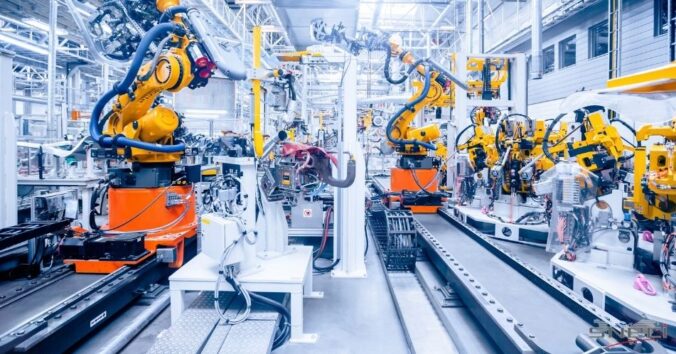When Lean Manufacturing is used to improve industrial performance

Born from the Japanese automotive industry in the 50’s, Lean Manufacturing allows to increase the industrial performance through the limitation and the elimination of the waste within the produced processes.
Lean Manufacturing brings together the notions of discipline, rigor and scientific thinking related to the operation and development of the company.
It is a management method mainly focused on the improvement and growth of industrial performance through the 5 zeros (Zero delay, Zero stock, Zero paper, Zero defect, Zero failure).
Definition of Lean Manufacturing :
The Lean Manufacturing method was born in the 50’s with the Toyota production system.
At that time, Toyota’s engineers combined different industrial techniques such as Henry Ford’s assembly line, Frederick Taylor’s modern management and industrial engineering techniques, and Dr. W. Edwards Deming, better known as the father of modern quality management, in order to not only improve quality but also to increase productivity in order to make the company one of the biggest names in the world automotive market.
This combination gave birth to the TPS (Toyota Production System) allowing Japanese productivity and quality to supplant North American factories.
The term Lean Manufacturing was adopted to encourage the adoption of TPS methods.
Lean Manufacturing is a method of organization and optimization of industrial performance that aims to better meet customer requirements in terms of cost-quality-delay.
Why set up a Lean Manufacturing approach :
The Lean Manufacturing method aims to improve processes and move towards continuous improvement by eliminating all types of waste present in a production process.
Indeed, each production system includes tasks with more or less added value, useful and necessary to the production process as well as tasks with less added value.
These tasks are then listed in 3 families of waste.
- Muda (tasks without added value, but accepted)
- Muri (tasks that are excessive, too difficult or even impossible) and
- Mura (irregularities and fluctuations)
This is where Lean Manufacturing comes in. Its objective is to increase value-added activities by reducing those of lesser value that are not necessarily useful while completely eliminating waste that has an impact on the company’s productivity and profitability.
Thus, Lean Manufacturing offers companies a competitive advantage over their counterparts thanks to the methods and tools put in place allowing for greater flexibility and responsiveness to customer demands.
Thanks to Lean Manufacturing, companies waste less, they have shorter production cycle times, less bureaucracy, more versatile and competent employees, more delegation between employees, a more efficient organization … all this leads to more productivity.
More productivity through Lean Manufacturing means more customers because production is launched in a way to reduce unnecessary stocks while responding to customer demands and because processes are more efficient, customers are more satisfied and long-term success is guaranteed thanks to the indicators and performance monitoring set up to control the activity.
The different tools of « Lean Manufacturing »
To achieve the objectives of Lean Manufacturing, different tools exist to act on the different areas of the company. These tools are grouped by process family.
Group 1: for a fair production and better managed stocks:
TAKT TIME or the just-in-time culture: In order to better respond to demands without “over-stocking” or “over-producing”, the company must set the pace of Takt time. This approach allows the company to produce the right quantity at the right time, thus reducing the storage of finished products waiting to be delivered. No more unnecessary downtime.
Heijunka (leveling box) or planning for more fluidity in production: is a scheduling technique that ensures the smoothing of the production of different categories of products manufactured. It is a visual management tool.
Kankan or new rhythm = new organization: to adapt the different stages of its logistic flows to the demand, the factory must organize its production lines in Kanban loops. The manufacturing and handling requirements are materialized by cards (also called Kanban in Japanese) indicating the information specific to the product requested, thus signalling that certain batches have been started and that it is time to restock.
The advantage of these 3 tools is to adjust the production so as not to “over-produce” and therefore not to “over-stock”, to largely reduce the storage of finished products and to facilitate the communication of the needs of each production station.
Group 2: Investing in people to reduce long-term costs
Training: a fundamental element for better preparing the future. It allows us to involve our employees, raise their awareness, make them more independent and increase their skills.
The 5S site: for a healthy and safe base. The 5S come from Japan and respectively indicate Seiri (整理) clear/sort, Seiton (整頓) tidy, Seiso (清掃) clean, Seiketsu (清潔) standardize, Shitsuke (躾) perennialize.
Standards or the basis of continuous improvement: defining standards, or “operating procedures” helps explain the “HOW” to perform a task/operation, not the “WHAT” to perform.
These 3 tools allow to involve the employees in a global approach of success of the company while reducing the manufacturing defects, by decreasing the risks of breakage of tools or machines, by anticipating the incidents and by reducing the number of work accidents. In this way, employees are more efficient, production increases and, by the same token, sales increase over the long term.
Group 3: To prevent and counteract flow failures
Jidoka, one of the two pillars of TPS: or how to detect problems as early as possible, stop them, and thus avoid producing defective products.
The Andon, a real time visualization: On an Andon panel, real time production information is displayed. This information reminds us of the objectives set, the progress of the overall production and, above all, the anomalies reported either by the operator (usually manually via a cord) or by the machine.
Maintenance, a good way to anticipate: in addition to the Andon panels which allow a quick intervention of the maintenance services. The employees dedicated to autonomous maintenance must prevent malfunctions through a series of checks and maintenance actions.
These 3 tools reduce the number of anomalies and facilitate collaboration between operators and local managers. Thus, thanks to a close collaboration, the different potential sources of malfunctions are identified and permanent solutions can be quickly implemented, allowing to reduce considerably the breakage of machines or tools as well as the stoppages and slowing down of the production line.
Group 4: To avoid manufacturing defects
The Dantotsu method: to analyze, understand and learn from one’s mistakes and to solve problems so that they are never repeated.
The Muda, sources of inspiration and progress: to highlight an additional way to find the details at the origin of defects. Among the 7 mudas, the ones that allow us to fight against quality problems are the Muda of waste in manufacturing processes and the Muda of waste in unnecessary treatments.
The Poka-Yoke, or “deception”: a device against errors that avoids defects and aims at a production directly in “zero defect”. It is a simple device, integrated into machine tools, tooling and equipment, allowing to avoid manufacturing errors of human or mechanical origin, and to meet the objectives of zero defects. Poka-Yoke designates both the deception device itself, but also the process of creating these devices.
These 3 tools allow us to identify the origin of any potential malfunction and to implement sustainable solutions in order to significantly reduce the number of defective products while identifying the sources of waste that can have an impact on production.
Group 5: To involve and engage employees in a continuous improvement process
Kaizen or the search for improvement: allows to diagnose the existing situation, to observe the anomalies and to find corrective measures based on the field experience.
Jishuken or collective competence: allows teams to increase their skills and independence over the long term by transmitting good practices to all levels of the company.
These 2 tools allow to make the employees aware of the company’s methods, to reduce slowdowns and dysfunctions through common rules and procedures.
Group 6: To manage and reach objectives
The Hoshin Kanri for a better visualization: this chart allows to visualize the progress of the different projects that serve the global ambitions. It summarizes the key stages, objectives and indicators to be monitored.
Daily Management: ensures that all the conditions of the organization respect the standards established at a given moment. As a result, the results obtained are in line with the expected objectives.
Genchi Genbutsu or the facts to better understand: translated as “go to the source to check by, and for yourself”. In operational terms, this means not being satisfied with a report, messages or photos, but going as close as possible to the problem in order to observe, feel, guess at the threats and form one’s own opinion.
Through these tools, employees are involved in the global strategy of the company and thus feel not only valued but also empowered in their decision-making.
SNECI and Lean Manufacturing support
With 70 years of experience in improving industrial performance with strong roots in the automotive, defense, health, rail, luxury, energy, … and with more than 450 experts worldwide in more than 50 countries, SNECI supports manufacturers and suppliers in the implementation of a Lean Management approach to increase their productivity and profitability.
More concretely, our experts accompany you in a detailed analysis of the different steps that make up your production process, and then we set up a convergence plan to help you eliminate all the waste identified throughout the manufacturing process in order to be more efficient and more profitable, but above all, more competitive at the international level.
Our approach is based on the 7 main categories of waste recognized :
- Overproduction
- Unnecessary treatments or steps in the manufacturing process
- Overstock and superfluous inventory
- Unnecessary operations and movements
- Waiting times
- Unnecessary transportation and travel
- Errors, defects and scrap, as well as underutilization of skills
If you would like one of our industrial project managers to assist you in improving your processes for greater profitability (saving time, money and efficiency), send an email to Laura who will reply within 24hrs to arrange a meeting at laura@sneci.com or directly via the contact tab on our website.






